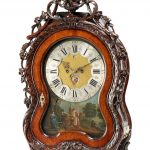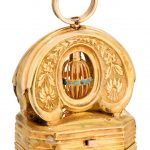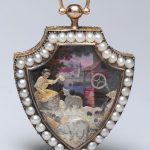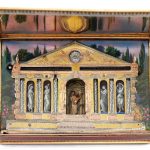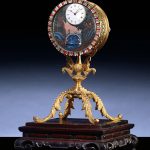Automaton Music Boxes. Automatons have been around since the Hellenistic era but they are more commonly recognized nowadays as toys which move to a defined pattern. However, automatons, or moving figures, were often incorporated into music boxes.
Below are some examples of automaton music boxes including a ship table clock and an enamel and pearl music box with a temple automaton.
A DUTCH CARVED WALNUT QUARTER STRIKING AUTOMATON TABLE CLOCK WITH MUSICAL MOVEMENT Signed Gerrit Tervooren en Soon, Amsterdam, third quarter 18th century and later The waisted case surmounted by a carved urn and draped with vines, raise on paw feet, the painted dial with silvered arcaded roman and arabic chapter ring enclosing apertures for date and day of week and ringed winding holes in the gilt center, above a painted village scene incorporating an aperture for moon phase, the assembled villagers listening to an automaton figure playing a serinette while a fisherman dips his line, twin fusee movement with plain rectangular plates joined b knopped pillars, verge escapement, striking the hour on a bell with passing strike for the quarters on a smaller bell, formerly with contemporary musical movement, now with an adapted late 19th century cylinder music box movement, signed Ducommun Girod 12758, wound through and operated by levers in an engraved brass plate.
Sold for US$ 4,000 (£ 3,092) inc. premium at Bonham’s in 2015
Automaton in the form of a ‘nef’ or ship table ornament. Gilded brass hull with embossed decoration of the sea with waves and monsters. Three masts with yard arms carrying furled cloth sails. At the top of each mast a metal pennant. Wire rigging ropes and waxed thread ratlines.
Within the hull, spring-driven clockwork mechanisms operated the automaton figures and provided motion for the machine to run along and also pumped the bellows to provide air for the regal. On the starboard side of the movement a large rotating programme barrel operated the stop on the regal to play the music.
Reference: The British Museum
A SWISS ENAMELED GOLD MUSICAL AUTOMATON FOB-SEAL GENEVA, CIRCA 1840 oval base, the winding shaft set within an enamelled cagework aperture in flower-embossed surround, polished gold reeded base, the interior set with an automaton of a couple enjoying a romantic dalliance
Sold for GBP 10,000 at Christie’s in 2020
Music Box ca. 1815 Swiss Gold and enamel shield-form pendant, one side with automaton farmyard scene with water wheel, the other with a rose on a red background. Both sides bordered with half pearls.
Reference: The Metropolitan Museum of Art
French musical automaton, ‘L’Avocat’ (The Lawyer), 1895-1905
This is an automaton, a mechanical figure in the form of a barrister, which was made to move as if spontaneously through a concealed clockwork mechanism. Made around 1900, the barrister stands pompously behind a podium, opening and closing his mouth, blinking, tilting his head and moving his arms up and down, brandishing a written document. The device reveals its main purpose, to entertain, by producing music rather than spoken words.
Reference: Museum of Applied Art and Sciences
A RARE GOLD, ENAMEL AND PEARL SNUFF BOX WITH ‘TEMPLE’ AUTOMATON, MUSIC, WATCH AND VINAIGRETTE, SENÉ & NEISSER, GENEVA, 1807/1808 of rectangular book form, the front cover painted with a tensely-poised leopard contemplating a cluster of grapes within a chased and enamelled vine tendril border set with pearl grapes, opening to reveal a magical temple dedicated to Music and chased in four-colour golds over an enamelled ground painted with luxuriant trees and sprawling rose bushes: as the music plays the spiral glass columns and architrave scintillate with changing colours, the sun spins in the pediment and in the centre, double doors open to reveal an articulated dancer and musician perform before a ‘gothick’ backdrop that slides to reveal an inner sanctury with a flaming altar to Love, the spine of the book divided into four sections each framed by pearls and decorated with trophies of Gardening and Plenty, the top section concealing a watch with white enamelled outer ring and arabic numerals on a sablé ground, the two central sections opening together to form a key compartment, the bottom section enclosing a tiny vinaigrette with pierced grille, the three further sides enamelled in translucent scarlet, the back cover with a still life of fruits and flowers surrounding an antique urn,
Sold for 675,000 GBP at Sotheby’s in 2020
